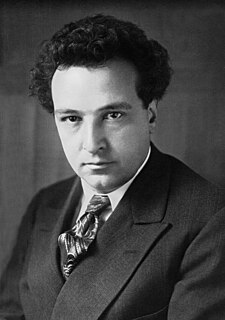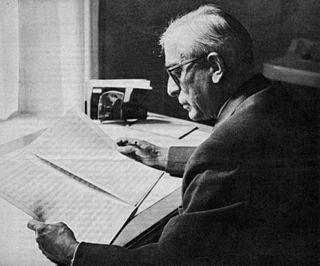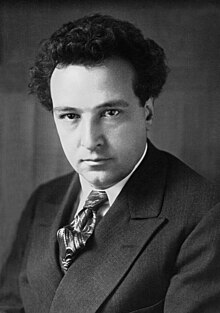
Arthur Honegger was a Swiss composer, who was born in France and lived a large part of his life in Paris. He was a member of Les Six. His most frequently performed work is probably the orchestral work Pacific 231, which was inspired by the sound of a steam locomotive.

A string orchestra is an orchestra consisting solely of a string section made up of the bowed strings used in Western Classical music. The instruments of such an orchestra are most often the following: the violin, which is divided into first and second violin players, the viola, the cello, and usually, but not always, the double bass.

Music for Strings, Percussion and Celesta, Sz. 106, BB 114 is one of the best-known compositions by the Hungarian composer Béla Bartók. Commissioned by Paul Sacher to celebrate the tenth anniversary of the chamber orchestra Basler Kammerorchester, the score is dated September 7, 1936.
Paul Sacher was a Swiss conductor, patron and impresario. He founded and conducted the Basler Kammerorchester (1926–1987). He commissioned notable works of composers of the 20th century and premiered them with the chamber orchestra. While better known for his interest in new music, he was also devoted to music of baroque and classical eras; he founded the Schola Cantorum Basiliensis, institute for early music, in 1933.

Serge Alexandrovich Koussevitzky was a Russian-born conductor, composer and double-bassist, known for his long tenure as music director of the Boston Symphony Orchestra from 1924 to 1949.

Jeanne d'Arc au bûcher is an oratorio by Arthur Honegger, originally commissioned by Ida Rubinstein. It was set to a libretto by Paul Claudel, and the work runs about 70 minutes.

La Création du monde, Op. 81a, is a 15-minute-long ballet composed by Darius Milhaud in 1922–23 to a libretto by Blaise Cendrars, which outlines the creation of the world based on African folk mythology. The premiere took place on 25 October 1923 at Théâtre des Champs-Élysées in Paris.

Pacific 231 is an orchestral work by Arthur Honegger, written in 1923. Honegger was widely known as a train enthusiast, and once notably said: "I have always loved locomotives passionately. For me they are living creatures and I love them as others love women or horses."

Marcel François Paul Landowski was a French composer, biographer and arts administrator.

Conrad Arthur Beck was a Swiss composer.
Igor Stravinsky's Concerto in D ("Basle") for string orchestra was composed in Hollywood between the beginning of 1946 and 8 August of the same year in response to a 1946 commission from Paul Sacher to celebrate the twentieth anniversary of the Basler Kammerorchester, and for this reason is sometimes referred to as the "Basle" Concerto.
Capricorn Concerto, Op. 21, is a composition for flute, oboe, trumpet and strings by Samuel Barber, completed on September 8, 1944. A typical performance lasts approximately 14 minutes.

Le Roi David was composed in Mézières, Switzerland, in 1921 by Arthur Honegger, as incidental music for a play in French by René Morax. It was called dramatic psalm, but has also been performed as oratorio, without staging. The plot, based on biblical narration, tells the story of King David, first a shepherd boy, his victories in battle, relationship to Saul, rise to power, adultery, mourning of his son's death, and finally his own death. The work has 27 musical movements, some instrumental, most for voices and orchestra. A narrator connects the scenes, soloists take different roles.

Pastorale d’été, H. 31, is a short symphonic poem for chamber orchestra by Arthur Honegger. It was inspired by Honegger's vacation in the Swiss alps above Bern in 1920. A typical performance lasts about seven or eight minutes.
A Colour Symphony, Op. 24, F. 106, was written by Arthur Bliss in 1921–22. It was his first major work for orchestra and remains one of his best known compositions.
Marcel-François-Georges Delannoy was a French composer and critic. He wrote operas, ballets, orchestral works, vocal and chamber works, and film scores.

The Symphony No. 1 by Swiss composer Arthur Honegger is a work for orchestra, written between December 1929 and May 1930 for the fiftieth anniversary of the Boston Symphony Orchestra. Its first performance was given in Boston on February 13, 1931, under Serge Koussevitzky.

The Symphony No. 4 by Swiss composer Arthur Honegger is a work for orchestra, written in 1946 on a commission from Paul Sacher. Subtitled Deliciæ Basilienses, it was first performed on 21 January 1947, by the chamber orchestra Basler Kammerorchester under Sacher. On the same program were the premieres of two other works commissioned by Sacher: Igor Stravinsky's Concerto in D and Bohuslav Martinů's Toccata e due Canzoni.

Concerto da camera is a concerto in three movements for the unusual combination of flute, English horn, and string orchestra written by Arthur Honegger late in his career in 1948.
Bohuslav Martinů's Double Concerto for Two String Orchestras, Piano, and Timpani was written in Switzerland in 1938 during deteriorating diplomatic relationships throughout Europe. Commissioned by Paul Sacher for the Basel Chamber Orchestra, it reflects intense impressions, from both the composer's personal life and the political events of the time.







